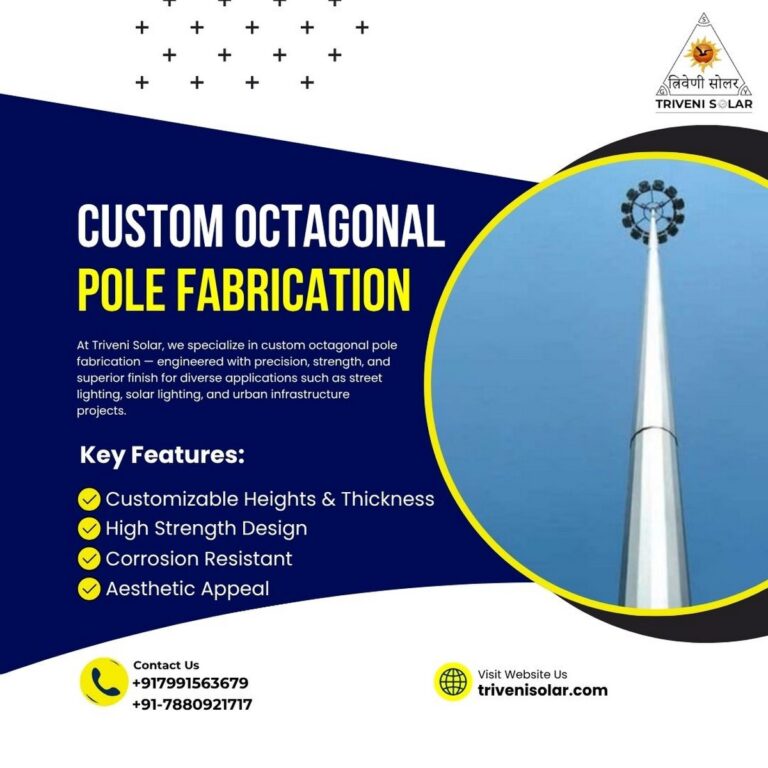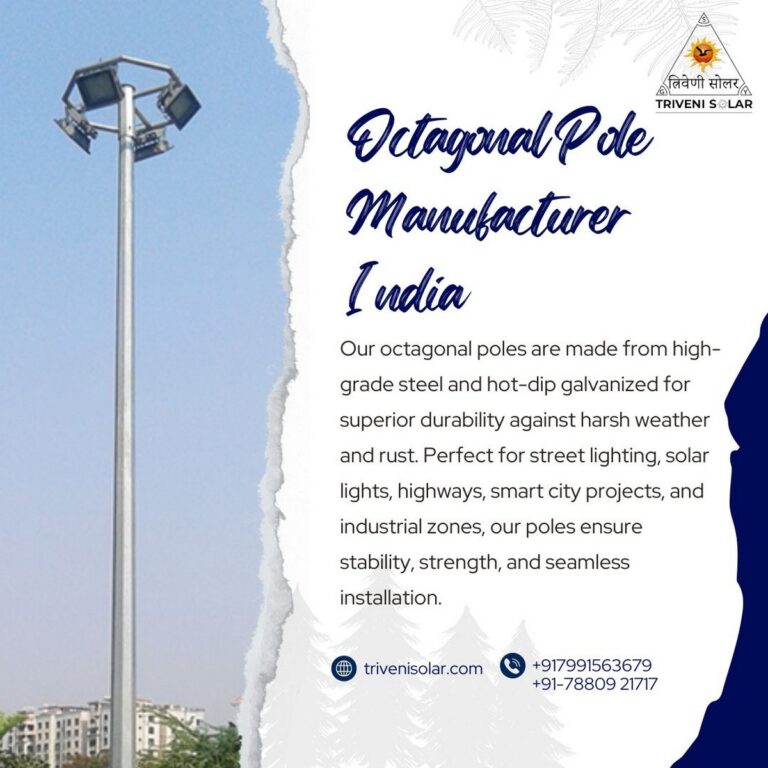Octagonal pole fabrication is the process of manufacturing eight-sided steel poles designed for streetlights, solar lights, and CCTV. Using advanced cutting, welding, and galvanizing, these poles provide strength, durability, and compliance with Indian and international standards.
Octagonal Pole Fabrication —The Ultimate Guide to Durable Infrastructure
In India’s rapidly growing urban and industrial landscape, octagonal pole fabrication plays a crucial role in powering infrastructure projects. From street lighting and solar smart poles to CCTV and telecom applications, these poles offer superior durability, aesthetics, and safety compared to conventional poles. As cities modernize and smart city projects accelerate, the demand for Triveni Solar’s fabricated poles continues to rise.
Why Octagonal Poles Are the Future of Lighting Infrastructure
Unlike traditional circular or tubular poles, octagonal poles provide unmatched advantages:
- Strength & Stability: Engineered to withstand heavy wind loads.
- Aesthetics: Sleek, modern design that complements smart cities.
- Flexibility: Supports street lights, signage, traffic signals, and solar panels.
- Durability: Hot-dip galvanization ensures 25+ years of life with minimal maintenance.
With governments prioritizing smart, sustainable infrastructure, octagonal poles have become the backbone of India’s lighting systems.
The Complete Octagonal Pole Fabrication Process Explained
Material Selection & Standards
The journey starts with premium-grade steel plates, often conforming to IS:2062 E250 or ASTM/EN standards. Selecting the right material ensures strength, weldability, and corrosion resistance.
Cutting & Forming
Steel sheets are cut using CNC machines for precision. They are then bent and shaped into an eight-sided profile that distributes load efficiently.
Welding & Assembly
Using Submerged Arc Welding (SAW), seams are welded for superior strength and a seamless finish. Base plates and foundation bolts are added for stability.
Galvanizing & Finishing
Hot-dip galvanization provides a protective zinc coating. For enhanced aesthetics, poles may also be powder-coated or painted in customized colors.


Technical Specifications of Octagonal Poles
Octagonal poles come in different heights and thicknesses depending on the application:
| Height | Thickness | Base Plate Size | Wind Load Capacity |
|---|---|---|---|
| 3–6 m | 3–4 mm | 200 x 200 mm | Upto 120 km/h |
| 7–10 m | 4–6 mm | 250 x 250 mm | Upto 150 km/h |
| 11–15 m | 6–12 mm | 300 x 300 mm | Upto 180 km/h |
Octagonal Pole Fabrication Applications Across Industries
- Street Lighting for highways, smart cities, and rural areas.
- Solar Lighting poles integrated with panels & batteries.
- CCTV & Security Poles for public safety.
- Signage & Flag Poles for highways and industrial zones.
- Telecom & Smart Infrastructure projects.
Octagonal vs Conventional Poles
How do octagonal poles compare with other types?
| Feature | Octagonal Pole | Tubular Pole | Concrete Pole |
|---|---|---|---|
| Strength | High (withstands strong winds) | Medium | Low–Medium |
| Durability | 25+ years (galvanized) | 15–20 years | 10–15 years |
| Aesthetics | Sleek & modern | Basic | Bulky |
| Cost | Medium | Low | High |
Quality & Safety Standards in Pole Fabrication
Triveni Solar ensures compliance with IS codes, ASTM standards, and other certifications. Every pole undergoes:
- Bend tests
- Load-bearing tests
- Galvanization thickness checks
- Visual inspections for weld quality
Octagonal Pole Fabrication Sustainability & Environmental Aspects
Steel is 100% recyclable, making octagonal poles eco-friendly. Modern galvanizing methods reduce environmental impact while ensuring durability. With solar integration, these poles further contribute to sustainable infrastructure.
Cost Factors & Buyer’s Checklist
Pricing depends on height, thickness, galvanization, and customization. Before buying, ensure:
- Material meets IS or ASTM standards.
- Hot-dip galvanization is uniform.
- Base plate & anchor bolts are included.
- Supplier provides test certificates.
Maintenance & Lifespan of Octagonal Poles
With proper galvanization, poles can last 25–30 years. Regular inspections every 3–5 years help detect corrosion, loose bolts, or wear. Repainting or recoating may be applied for extended service life.
Case Studies: Successful Installations in India
- Smart City Projects: Octagonal poles installed for LED streetlights in metro cities.
- Solar Highways: Highway projects using galvanized poles for solar lighting.
- Industrial Complexes: Triveni Solar’s fabricated poles for CCTV & lighting solutions.
FAQs on Octagonal Pole Fabrication
What is the standard height of octagonal poles?
They range from 3 to 15 meters, depending on application requirements.
How durable are galvanized octagonal poles?
With proper galvanization, they last over 25 years with minimal maintenance.
Are octagonal poles better for solar streetlights?
Yes, they offer strength, corrosion resistance, and modern aesthetics ideal for solar integration.
How much does an octagonal pole cost in India?
Prices vary based on size, thickness, and finish but typically range from ₹4,000 to ₹15,000 per unit.
What maintenance is required?
Regular inspections, rust prevention coatings, and bolt tightening ensure long-term reliability.
Conclusion: Why Choose Triveni Solar for Octagonal Pole Fabrication?
Octagonal poles are no longer optional—they’re the standard for modern infrastructure. Their strength, durability, and aesthetic appeal make them the first choice for governments, industries, and solar projects across India.
Triveni Solar is a trusted name in octagonal pole fabrication, offering high-quality, certified, and durable poles tailored for every project.
📞Contact us today for customized octagonal pole solutions that power the future of smart infrastructure.




